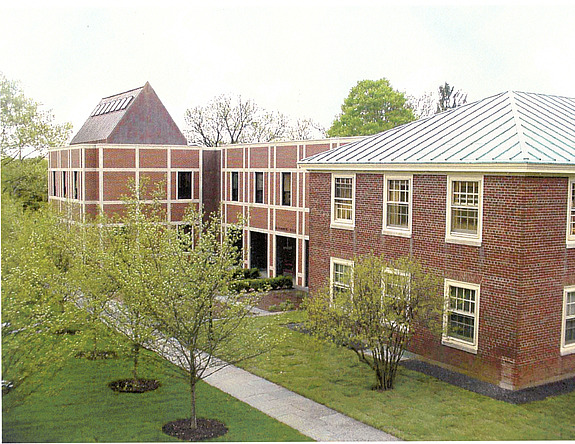Institute For Advanced Study Dedicates Bloomberg Hall

Bloomberg Hall, named in honor of former Institute for Advanced Study Trustee Michael Bloomberg, Mayor of the City of New York and Founder of Bloomberg L.P., was dedicated today on the Institute’s campus on Einstein Drive in Princeton, New Jersey. The building is the new home of the Institute’s School of Natural Sciences, which provides a unique atmosphere for research in broad areas of theoretical physics.
Over the course of the 20th century nearly every individual who made a significant contribution to physics spent some time working at the Institute, from individuals whose contributions were of critical importance but whose names would probably not be recognized by the general public, to the physics “superstars:” Institute Faculty member Albert Einstein; Wolfgang Pauli; Niels Bohr; and P.A.M. Dirac, to name just four.
Bloomberg Hall marks a new era in the School of Natural Sciences, which for the past forty years has been housed in several separate buildings. A complex of new and existing buildings, Bloomberg Hall links two buildings constructed in 1948 and 1953 to create a structure 30,000 square feet in size. The new building provides offices for faculty and visiting scientists, meeting rooms, two library reading rooms, and a lecture hall that seats 65 people and has state-of-the-art audiovisual equipment. An important goal in housing the entire School in one building is to encourage the informal interactions which are a central part of both scientific research and postdoctoral education in the sciences. “This is the first time since its founding in 1966 that everyone in the School is united in one building,” commented Professor Edward Witten, Executive Officer of the School of Natural Sciences. “Bloomberg Hall will facilitate both communication and collaboration.”
The School of Natural Sciences’ permanent Faculty of six distinguished scientists interacts closely with the approximately fifty men and women who are invited each year to work in the School in various areas of particle physics and astrophysics. These scientists interact freely and creatively with an even larger group at the Institute working in closely allied areas of forefront mathematics. The areas of greatest current interest in the School include elementary particle theory, condensed matter theory, quantum theory, quantum gravity, theoretical astrophysics, mathematical physics, and computational physics.
An integral part of Bloomberg Hall is work by the artist Mary Miss, who designed a series of sculptures located in a grove of trees on the northern side of the building. Mary Miss has long been concerned with integrating art into the public realm. Her Bloomberg Hall work uses reflective lines of water elements echoed at different scales and levels in the surrounding site. Collectively, the trees, paving elements and maze-like structures suggest the remnants of an orchard, rich with layered meanings and allusions and evocative of the site’s past use as a farm, and the orchard that once existed.
Robert Geddes of Geddes Demshak Architecture and Planning is the Design Architect for Bloomberg Hall, and the Architect of Record is KSS Architects. Both firms received the highest award of the New Jersey Chapter of the Architectural Institute of America for their design.
Planning for Bloomberg Hall was a collaborative process between the architects and the Faculty of the School of Natural Sciences, who created specifications for the new structure and requested a building that evoked a “sense of collaboration, warmth, and friendliness while facilitating quiet, individual study and research.” They wanted the design of Bloomberg Hall to encourage and stimulate the community the School creates, and to support formal and informal interactions. At the heart of the building is the new 25' x 50' Common Room, the main entry and meeting place, serving as gathering room; coffee and tea room; mail room; browsing room; and transparent garden room overlooking both the Entry Court and the Garden Court. Slate-covered walls serve as blackboards, and workstations are provided here as well as current newspapers, magazines, and journals.
Bloomberg Hall creates its own special landscape within the Institute campus, and reinforces the original symmetry of the Institute landscape. Bloomberg Hall’s red brick exterior harmonizes with Fuld Hall, completed and occupied in 1939, and its flanking buildings.
The interior construction of the new building gives top priority to both encouraging interaction and collaboration, and to creating a quiet working environment. With its overall plan as a group of connected building wings which create garden courtyards, Bloomberg Hall continues a venerable and lively academic tradition. In each wing, the private individual rooms are in small groups. The seminar rooms and libraries are at central locations and the Common Room is at the interactive crossroads location. All of these elements work together to express, both pragmatically and symbolically, the human scale community of the School.
The Institute for Advanced Study, located on an 800-acre site in Princeton, New Jersey, is an independent, private institution whose mission is to support advanced scholarship and fundamental research in historical studies, mathematics, natural sciences, and social science. Founded in 1930, the Institute attracts some of the world’s most renowned scientists and scholars, including numerous Nobel laureates, recipients of the Wolf and MacArthur prizes, and winners of the Fields Medal. Perhaps its best-known Faculty member was Albert Einstein, an Institute Faculty member from 1933-1955.